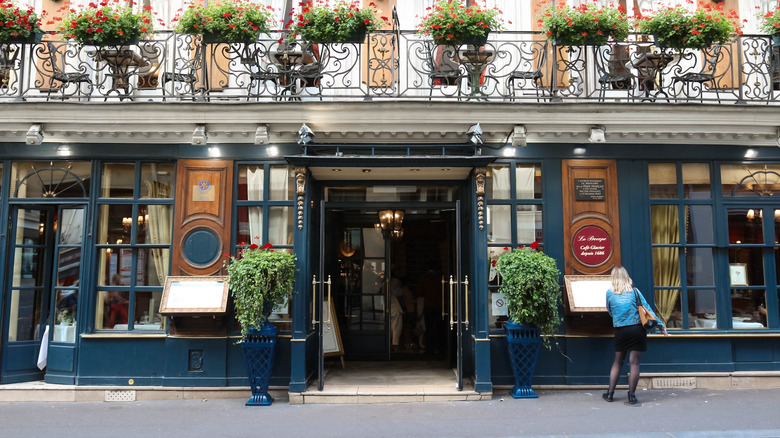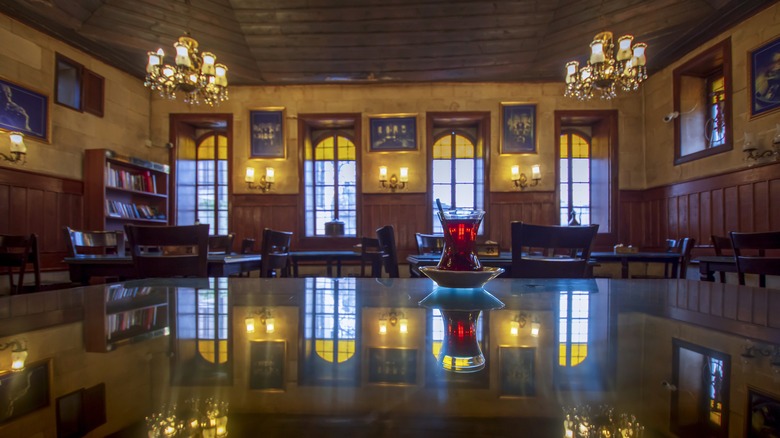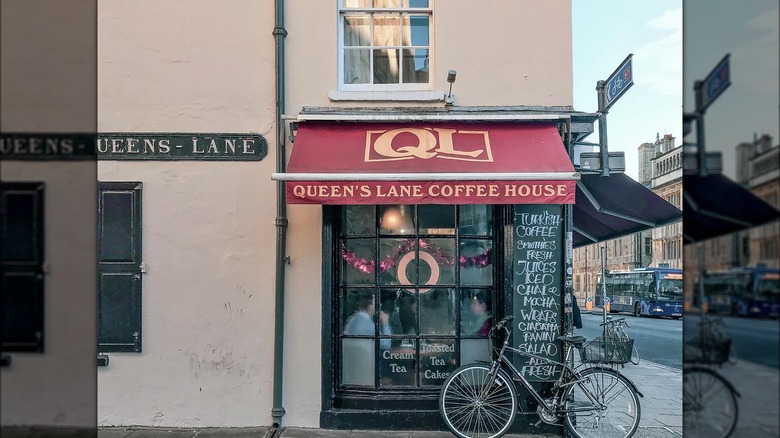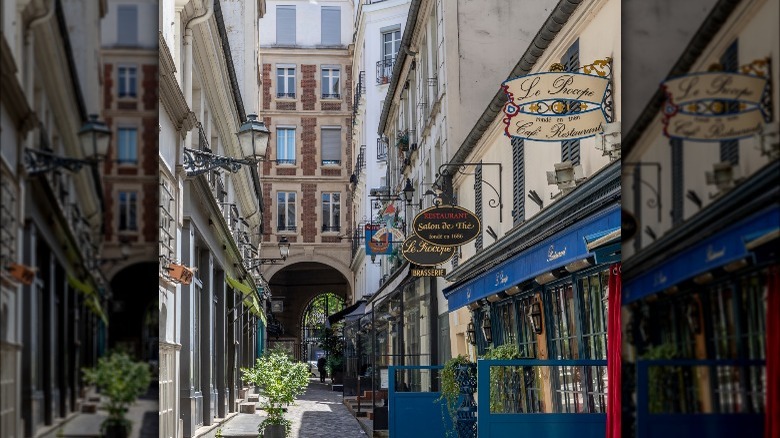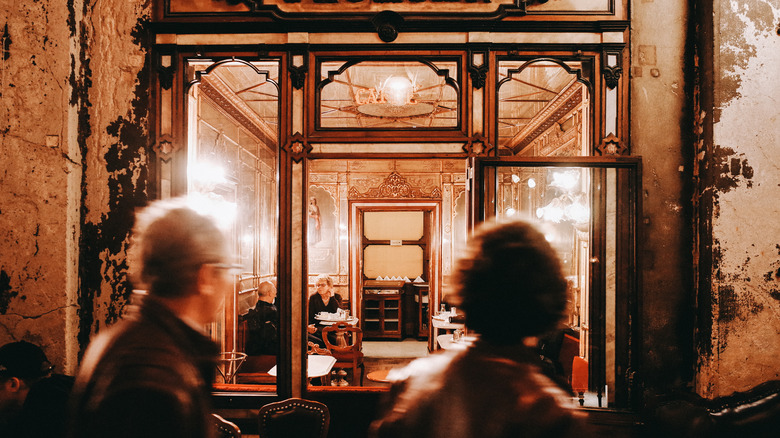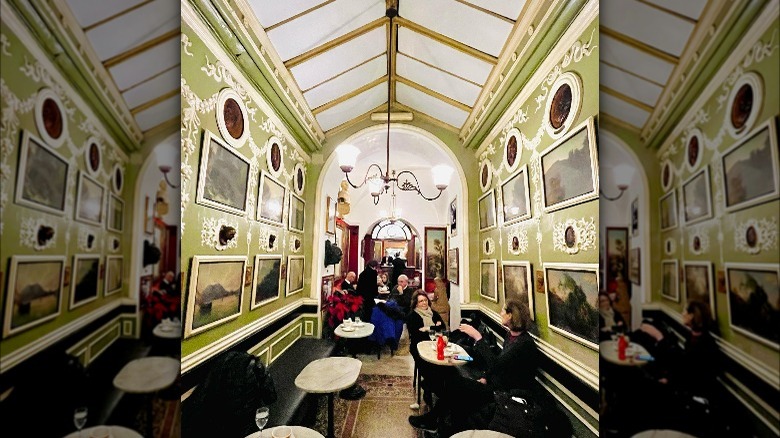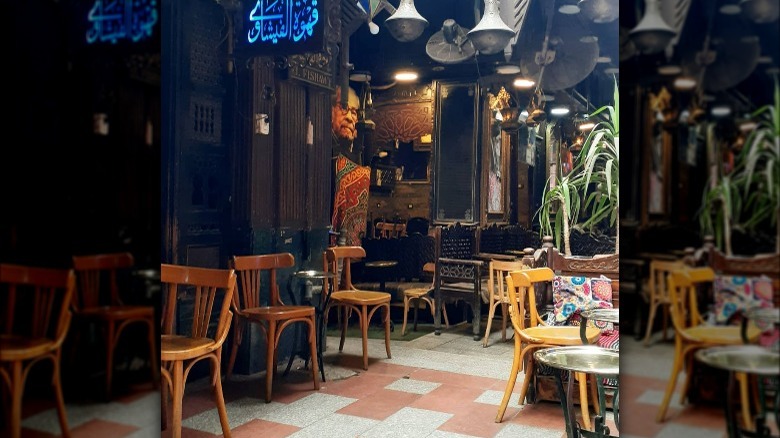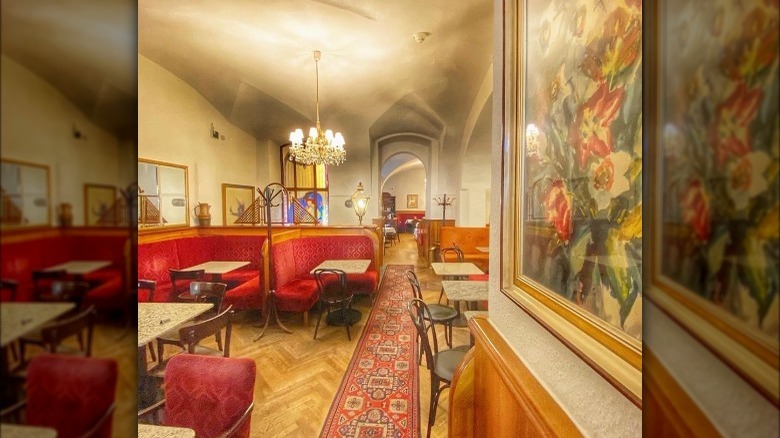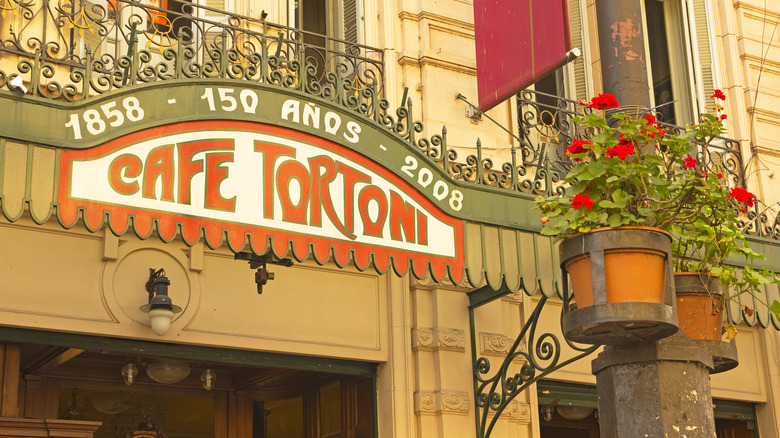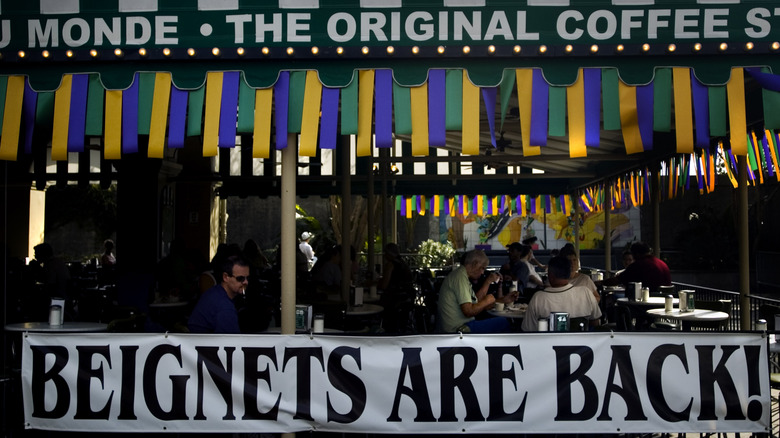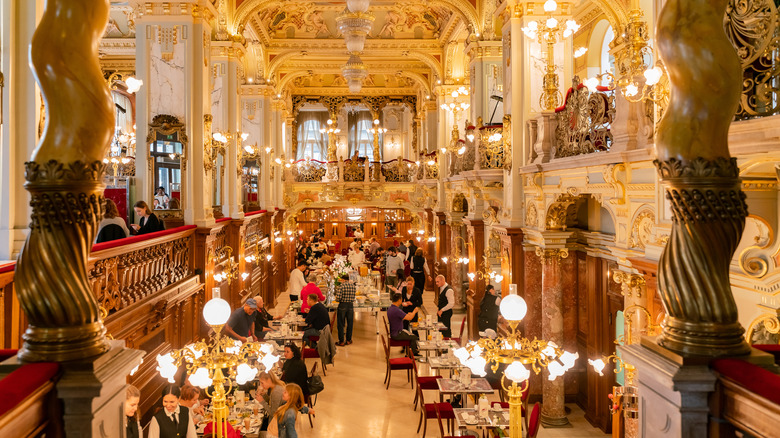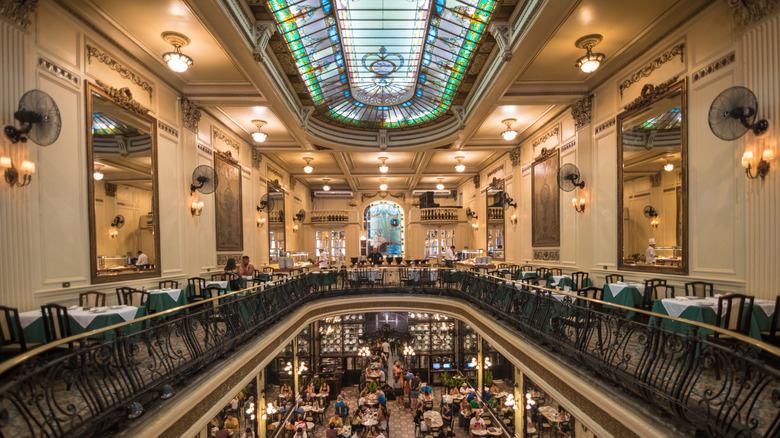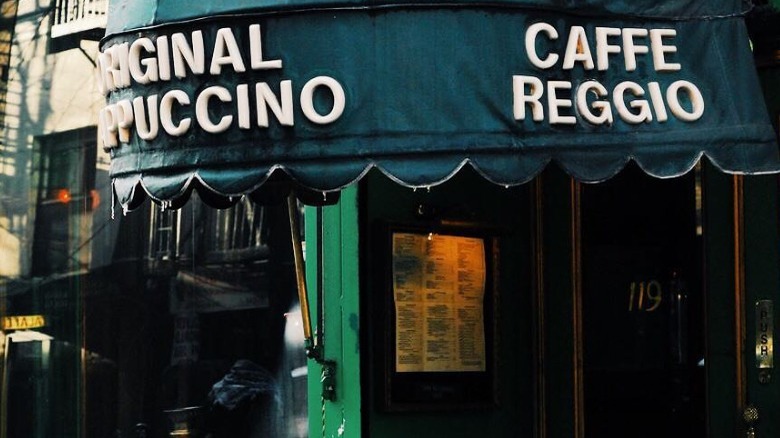The Oldest Coffee Shops In The World
Cafés and coffee shops have long been a valuable facet in the jewel of coffee culture. Sure, a cup at home is nice, but going out for an espresso with a friend or sipping on a frothy cappuccino while marinating in the ambience of a coffee shop is downright heavenly. After all, what would "Friends" be without Central Perk? Coffeehouses offer an oasis in contemporary society, a buzzy watering hole where friends meet, theses and novels are typed, conversations are shared, and street life is passively, yet joyously, observed. And what would singles' society be like without exchanging flirty looks overs cups of coffee while leaning forward on those bistro chairs?
But coffee shops didn't start with Central Perk. The Spruce Eats traces these caffeinated haunts as far back as 15th century Constantinople, now Istanbul. But the prowess of these otherwise quiet establishments doesn't stop there. Instead, it might just as well be that the historical significance of coffee shops is vastly underrated. An article from the New Yorker postulates that modern coffee shops even helped shape contemporary liberalism. It is safe to say that cafés have a long and wonderful history that touches upon many aspects of society. So, take a step back into history and check out the oldest coffee shops in the world.
Tahmis Kahvesi (1635) - Gaziantep, Turkey
The first-ever Byzantine café has sadly been washed away by the waves of time though, interestingly enough, the world's other oldest known continuously-run café is still based in Turkey. Coffee has, after all, long been a beloved drink in this particular region. The Spruce Eats notes that, at some points in pre-modern Turkey, a woman could divorce her husband on the, ahem, grounds that he didn't have enough coffee.
There isn't much written about Tahmis Kahvesi in English, though the café clocks in at well over 1,000 reviews on Tripadvisor. It's safe to say that this old institution remains more than relevant. Which isn't to say that much has changed for this old-school café. Tahmis Kahvesi itself is located in a historical building with high-ceilings, beautifully stained windows and dark wooden furniture. Now, that certainly provides the ambience when joining in the age-old practice of enjoying a coffee at this establishment.
Tahmis Kahvesi sticks to a traditional Turkish coffee, a frothy and freshly brewed drink. Lonely Planet reports that the cafe's particular coffee is thick enough to "stand a spoon in." Located in the southernmost part of Turkey, this coffee house is fortuitously situated in the premier pistachio-growing region of Turkey. This makes its menengiç kahvesi, a caffeinated drink brewed from pistachio, a sublime local treat.
Queen's Lane Coffee House (1654) - Oxford, England
Queen's Lane Coffee House has leaned into change over the past decades, if not centuries! Located on Oxford's Queen's Lane, this coffee house was allegedly first founded in 1654, which would make it Europe's oldest known café. This claim has come a bit into question, however. Although Oxford's first coffeehouse was established on Queen's Lane, the current café has moved location and only been in business since the late '70s (via The Oxford Guide). Nonetheless, the history of the café and its location can still be traced back to its mid-17th century founding by Jewish-Syrian immigrant Cirques Jacobus, per the Oxford Jewish Heritage Committee.
Queen's Lane Coffee House, which rebranded as QL in 2009, is one of the more low-key joints on this list. Its wooden façade is only an indication of the coffee house's cozy and down-to-earth interior, where booths and round tables beckon for coffee lovers to come in and enjoy some easy dining. Large windows offer plenty of street viewing while sipping on typical café fares like cappuccino, espresso, and lattes. What is uniquely British is the coffee house's full British breakfast that will certainly leave any guest satiated. QL adds an interesting twist to its menu with Mediterranean as well as halal foodstuffs. It also serve Turkish coffee, which might just add a bright spark to the infamously gloomy English weather.
Café Procope (1686) - Paris, France
It is fitting that one of Europe's most enduring cafés is in none other than the cultural hub of Paris. First established in 1686, Café Procope was originally a Sicilian-led undertaking (via The Culture Trip). Also lovingly referred to as Le Procope, it has long since morphed into not just a French, but an undoubtedly Parisian, coffee experience. Located on the gorgeous Left Bank, it is a classic example of the café littéraire or literature café. These particular coffee houses exemplify the perfect union of a good coffee and a good book, whether you're reading or writing the next good book. Institutions like Café Procope have been home to impassioned conversations, a good game of chess, and lofty aims in the art of literature.
French literary legends such as Voltaire and Diderot were only a few of the major writers to find home at one of Le Procope's tables. To this day, Voltaire's desk is still preserved on the second level of the café. Even Americans such as Benjamin Franklin and Thomas Jefferson could be found indulging in conversation and café at Le Procope (via TripSavvy). Renovated in the late '80s in an ever-gentrifying location, Café Procope may be frequented more so by tourists than artistic locals now, but it still centers itself around the same tasse de café.
Caffè Florian (1720) - Venice, Italy
Caffè Florian has an opulent charm that is unquestionably Venetian, with its red velvet, gilded corners, and marble tabletops. There is such a flair and idiosyncratic boldness to this café that it's perfectly understandable why it has remained a cornerstone of Venice since its opening in 1720. This cafè has been in business for so long that it counts the likes of both Claude Monet and Andy Warhol among its many famous guests (via Architectural Digest).
Its staying power isn't all due to bygone days of glory, however, according to Travel Awaits. Though the coffee house's appearance might be ostentatious, the café is meticulous when it comes to food, drink, and service. It, of course, does not hurt that this coffee house has also become a hub for carnival debauchery, as per the Wall Street Journal. Ultimately, everything that is done there is done with intention, quality, and pizzazz. Maybe this is why the caffè has since been franchised and can be found as far afield as Asia.
The COVID-19 pandemic has not been easy for anyone, and has proven exceptionally difficult for cafés like this one to navigate. Even after surviving major historical upheavals like two world wars, Caffè Florian announced that it was in danger of closing shortly after its tricentennial in 2021. The fate of the café remains unclear, though as of 2022 is remains open and reviews keep rolling in.
Antico Caffè Greco (1760) - Rome, Italy
It is no surprise with Italy's monumental coffee culture, that two of its caffès make the list. Antico Caffè Greco, referred to simply as Caffè Greco, is another historic locale though located in Rome. First opened in 1760 by a Greek man named Nicola della Maddalena, this café, like many others of its time, became a second home to the revolutionary, artistic, and intellectual. The noteworthy patrons also exemplify Greco's lifespan: Shelley, Keats, and Princess Di were known to stop by for an espresso. Even Buffalo Bill and his cowboys wound up there! The photo evidence is hanging on the walls, as per the Metropolitan Museum of Art.
What makes this café especially unique is how important it was for artists. The Metropolitan Museum hypothesizes that the café's proximity to an art academy helped the caffè become the intellectual developing room of the Italian photography scene. The fact that smoking was allowed in every inch of the café might have also sweetened the pot for the notoriously indulgent artists.
NPR does note, however, that it's really not just that this caffè has had its fair share of remarkable visitors. The coffee served here is also excellent, serving as an example of just how good Italian-style caffè can be. While visiting, do pay mind that, unlike other Italian caffès, the Caffè Greco comes with a pretty price tag for its pretty drinks and prettier atmosphere.
El-Fishawy Café (1797) - Cairo, Egypt
El-Fishawy Café has long been in the biz. So long in fact, that they actually opened doors one year before Napoleon invaded Egypt (via Middle East Eye). El-Fishawy, a family name, is now run by the seventh generation of the same family that began this enterprise. The septuagenarian café started simply as a spot where friends could gather for Turkish coffee. It eventually snowballed into a venue of such regard that it was patronized by both Nobel laureates and the last Pharaoh.
Despite its age, El-Fishawy still offers a vibrant atmosphere, as giant mirrors, hanging chandeliers and dark furniture decorated with brightly patterned accents fill the café's dining room and terrace. There are so many mirrors that this café is referred to by the French as the mirrors café. Among the many antiques in the café is a stuffed crocodile gifted from a Sudanese prime minister (via the Cairo Governorate).
Reuters described the pre-pandemic coffee shop as often patronzied by visiting internationals and locals alike. Before pandemic-related restrictions, patrons could be found sipping on drinks and sharing shisha 24/7. Now, the café must close its doors more frequently than before, and the once fondly nicknamed "international café" now more often turns back to locals. Yet, as time moves forward, and history keeps being made, El-Fishaway continues to serve a splendid and powerful Turkish coffee.
Café Frauenhauber (1824) - Vienna, Austria
Viennese Kaffeehäuser, or coffee houses, are legendary. They are practically synonymous with elegant decor and zippy espresso-based concoctions, though it'd be much more in spirit to order a Wiener Mélange in lieu of the classic cappuccino. In a city that is so dedicated to the caffeinated drink, it is no surprise that there are some that have long been in the game. Today, Café Frauenhauber nears its bicentennial in a delightfully yellow building that outpaces its own founding by a solid century. The interior of the coffee shop is delightfully, if a bit eccentrically between eras (via Visiting Vienna). An art deco window installation guides patrons to the bathrooms, the café's high-vaulted white ceilings contrast the bright red upholstery and blond wood, paintings, and mirrors decorate, but do not busy the walls. Compared to other coffee shops, Frauenhuber might come off as quiet. Yet, really, it is timeless.
Café Frauenhuber is comfortable in its tradition. According to Histouring, it's as traditional a Viennese coffee house as it gets. Its menu sticks to that which defines the city's cuisines: schnitzel, apple strudel, tea, and an array of coffees decorate the menu. Those who find themselves in Frauenhuber's are advised to indulge in another well-loved local custom: accompanying a strong coffee with a good slice of cake, like the ever-rich Sachertorte. Pair everything with a game of chess and really soak in the rich history that defines Austria's coffee scene.
Café Tortoni (1858) - Buenos Aires, Argentina
Across the Atlantic is one of South America's longest perservering cafés: the Gran Café Tortoni, which is every bit as grand as the name implies. This Parisian-style café first opened its doors under the stewardship of a mysterious Parisian, Jean Touan (via Wander Argentina). Maybe this is the where the Parisian flair that still defines this café originates. This café traces its roots exactly back to a café in Paris of the same name. While the French café did not survive, the Argentinian coffee house is still kicking.
By now, the typical café visitor of yesteryear is quite clear: intellectuals, artists, and revolutionaries all stewed over their drink of choice in the caffeinated environment. In the Gran Café, such a past is hard to ignore, as the coffee shop is simply brimming with it, seeing as how photographs, books, and tchotchkes all decorate the well-worn, though loved, shop. There are even paper maché models of previous well-known regulars (via Just Luxe). In the last century, not much has changed in terms of the café's interior. The guests who visit the café, on the other hand, have transformed drastically. As the clientele shifts from local to international, the owner has noted that perhaps the internet has taken this already prestigious café and put it on the global map.
Café du Monde (1862) - New Orleans, United States
It probably won't come as a surprise that none other than the gorgeous and funky NOLA leads the pack in stateside cafés. Located in the historic and renowned French Quarter of the city, Café du Monde, loosely translated as "people's café," opened in 1862. It's no surprise that, with the French influence on the region and Southern food sensibilities, a café or two would pop up in the city. For those visiting the region, Café du Monde remains a popular (and well-rated) tourist destination, albeit maybe still underreported on the national circuit.
Louisiana Travel, of course, knows what's up and refers to Café du Monde as nothing less than a "New Orleans landmark." Though the outside looks unassuming, it does leave a lasting impression, with a distinctive green and white striped canopy that invites pedestrians to stop and sip in this predominantly open-air café. The menu offers up goodies that are hard to find anywhere else, like chicory coffee, a caffeine-free coffee alternative that tastes remarkably similar to the more traditional cup of joe. Purists might opt for a caffeine fix and choose instead to pair a café au lait with some hot beignets. The combo is perfect for sipping and dipping, after all.
New York Kavehaz (1894) - Budapest, Hungary
It's not every day that a café leaves its visitors breathless, but not every day is spent at New York Kavehaz, also known as the Café New York. One of Budapest's oldest and most legendary cafés, at around 125 years old, this coffee house was designed with the Italian Renaissance in mind (via CNN). Simply put, there is no choice but to take in its splendor as soon as setting foot in the door.
The café came at a boom-time for cafés in the already caffeine-hungry Hungarian capital. What sets it apart was intention. CNN noted that the café's original owners had the lofty goal of making the world's most beautiful café. The result? Stucco angels, frescoes, marble columns, high-vaulted ceilings, and paintings are only some of the many baubles inside. At first glance, it seems that only wealthy patrons would call this café home. It was writers, however, who gravitated towards this elegant space.
Hungary Today notes that the New York Kavehaz hasn't become a small museum, but is still a living and functioning coffee house. In the age of social media, it doesn't hurt that the coffee house doesn't just serve quality coffee, but that it is also a pleasure to behold. As recently as 2018, the café was receiving tune-ups and renovations to preserve its special sparkle.
Confeitaria Colombo (1894) - Rio de Janeiro, Brazil
Another certifiably gorgeous café, Rio's Confeitaria Colombo is one for the books. Café Colombo was even birthed at the same time as the New York Kavehaz, making 1894 an auspicious year for coffee. Like its Hungarian counterpart, this Brazilian café has a similar affinity for that which is beautiful. The café was originally built very much in line with the contemporary Belle Époque: high vaulted ceilings let soft yellow light into an otherwise dark-wood adorned tables, tiles, and floors (via Culinary Backstreets). A few tweaks and additions in the first quarter of the century added compelling Art Noveau accents to the café in the form of crystal mirrors and even a stained glass ceiling that illuminates the main dining hall. It's certainly an elegant affair.
Despite its European influence, there's a distinctly tropical and Brazilian twist to the entire café, one that is reflected in the coffee house's menu as well. Confeitaria translates to confectionary, after all. The café does more than sprinkle in its fair share of Brazilian treats, both traditional and experimental alike. Lonely Planet suggests pairing a visit to this spot with the classic Brazilian egg-custard dessert known as pastel de nata. A traditional Brazilian coffee, a cafezinho, or a nice dark shot of espresso will balance the taste out perfectly. All the while, the surroundings serve as delightful eye candy.
Caffè Reggio (1927) - New York City, United States
Another New York café (though this time actually in New York City), the Italian-inspired Caffè Reggio derives its name from the town of Reggio Calabria (via West Side Spirit). Caffe Regio wasn't even supposed to be a café, instead first opening as a barbershop. After a while the shop's predominantly Italian-American patrons became accustomed to an espresso served with their cut. It wasn't long until routine espressos turned into an espresso machine, which then turned into a caffè.
Eventually, Americans caught up with the coffee craze and Caffe Regio remains the most traditional of tried and true staples of the craft stateside. Some even say that Caffe Reggio is responsible for introducing the cappuccino to the States (via West Side Spirit). Maybe it's typical New York ego or maybe there's a grain (or bean) of truth to these claims.
Regardless of what started when, Caffe Reggio is undoubtedly a staple of the New York coffee scene. Films like "The Godfather Part II" show how beloved this haunt is, but long before the silver screen, the café has been home to modern American poets, writers, politicians, and artists (via Village Preservation). The more things change, right? Caffe Reggio values tradition, given that it didn't add food to its menu until the '50s, and it took a pandemic for the owners to debut outdoor seating. Perhaps that's the secret to its longevity: knowing when to not to gild the lily.
